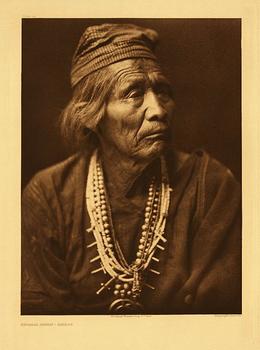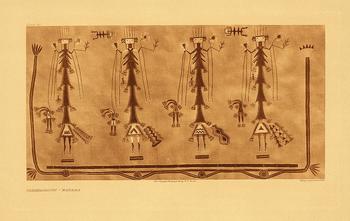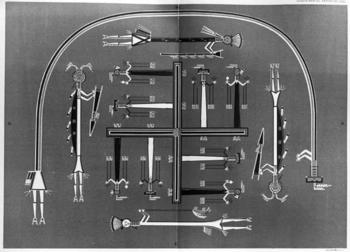Navajo Sand Paintings
Navajo native Americans or the Diné live in the southwest of the USA. They are famous for their sand paintings. Navajo word for the sand painting is "iikaah" which means "the place where the gods come and go".
 Navajo Medicine Man
Navajo Medicine Man
Sand paintings are part of the ceremony performed by the Medicine Man. He paints by letting the coloured sands flow through his fingers upon the ground of the Navajo traditional hut called hogan, where the ceremony takes place. Sand paintings can also be created on a buckskin or some other similar cloth.
Materials used to make the painting are ordinary sand of different colours, crushed gypsum (white), yellow ochre, red sandstone, charcoal, mixture of charcoal and gypsum, corn meal, flower pollen, powdered roots and bark.
The information that there are up to 1,000 different sand paintings known by the Navajo nation is absolutely fantastic.
 Navajo sand painting
Navajo sand painting
Sand paintings are used only for healing. Many of them include "yeibicheii" or "yeibeichai". They are known as the Holy People. The Holy People of Navajo are Snake People, Spider Woman, Corn People, First Man, First Woman and others. During the ceremony Medicine Man chants. He ask the yeibicheii to come into the painting and heal the person.
The finished painting has to be checked. Everything has to be in order. The order and symmetry presented in the painting symbolize the goal or the state of harmony healed person needs to achieve. Accuracy of the painting correspond with the effectiveness of the sacred tool.
Now when everything is ready the person sits on the sand painting and the Medicine Man continues with the ceremony.
The sand painting is kind of media for spirits to come and go. It also attracts them.
Person sitting on the sand painting absorbs some of the power of the spirits. They on the other side absorb the illness of the person which is being healed.
 Navajo sand painting
Navajo sand painting
At the end of the ceremony the Medicine Man dips his fingers into a liquid and then splash some of this liquid onto the sand painting. After the ceremony the sand painting is destroyed. Some people present at the ceremony take little bit of the sand used and keep it in a pouch around their necks.
The Medicine Man disposes the used sand in a strict ceremony. He walks along the following route – east – south – west – north. Then he thanks to Father Sky and Mother Earth and scatters the sand in six directions or just buries it.
Everything from creating the sand painting till its destruction has to be done within 12 hours.
The chant is a name of the sequence during which the healing is done. All chants are connected with the Navajo origin myth. The most common chant used in the ceremony is the Blessing Way. It is short and it can be used in many situations.
Chants can last for 5 to 9 days. New sand painting is made every day.
The sand paintings are extremely important to the Navajo people. Some more rules are observed.
Chants about the yeibicheii are sang only by men. It is believed that this chants can hurt the unborn child. Women which have menstruation also can not sing the chants. That means that women of post-menstrual age can somehow participate in the event.
Only real medicine man has the right to create the sand painting. It takes lot of time and effort to become a medicine man. He has a special status in every Navajo community.
Before the ceremony medicine man has to pass three day period of purification, fasting, sweating, vomiting, sexual restraint, bathing, and a lone vigil. During this period he also collects the above mentioned materials he is going to use to make a sand painting.
The medicine man like and other doctor receives a fee for his work. Fees are agreed before the ceremony and may include money, beads or some cattle.
Sand paintings are truly private stuff of Navajo communities. To somehow satisfy the interest of curious people kind of fake sand paintings are made. They do not have the purpose like the real ones used in healing. They look very nice and are sold to tourists.